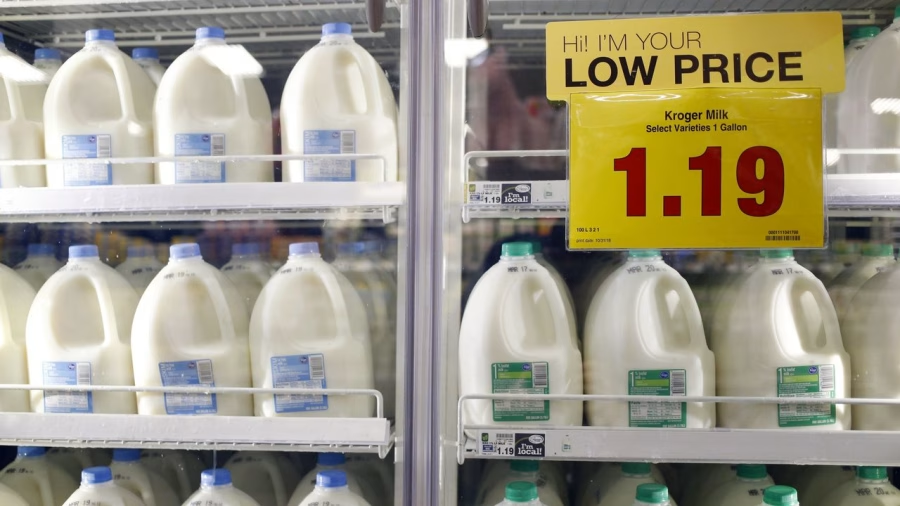Are you ready for the USDA’s new Federal Milk Marketing Order reforms? Find out how these changes could impact your dairy farm. Stay prepared for what’s coming!
Imagine waking up to a world where the regulations governing your milk prices have changed, and you only have a few days to voice your concerns. This is the reality for dairy producers in the United States. The USDA has proposed new Federal Milk Marketing Order (FMMO) pricing formulae, a decision that could reshape the dairy industry’s future. Understanding the potential impact is not just important; it’s crucial. ‘Any dairy farmer who feels these changes might affect them should consider what they mean—not just in terms of price fluctuations but also the potential unintended consequences,’ stated a representative from the USDA. The 60-day public feedback period ends on September 13, 2024. This is your chance to make your voice heard. Don’t miss the opportunity to influence a decision shaping your future. So, what does this mean for you? Let’s delve into the details.
The Future of Milk Pricing: Your Voice Matters as USDA’s Deadline Approaches
The USDA has recently unveiled its recommended judgment on the new Federal Milk Marketing Order (FMMO) pricing formulae. This crucial information has sparked widespread interest in the dairy business. As we approach theSeptember 13, 2024 deadline, stakeholders have a unique opportunity to shape the future. This public comment phase is not just important; it’s pivotal. It empowers industry participants to influence the final decision, whether it becomes part of government directives or operates independently. After reviewing these comments, the USDA will determine the changes to the milk price environment. Your voice matters. Your input can make a difference.
Brace Yourself! Significant Changes to Milk Pricing Ahead
The proposed reforms carry significant direct implications for the sector. These early effects will primarily manifest in price changes, potentially impacting producers and handlers pooled under the FMMO system. The potential impact of these changes cannot be overstated.
- Increased Milk Prices
Updating the milk composition parameters will increase milk pricing in specified orders. Higher expected component levels in skim milk, such as 3.1% protein, 5.9% other solids, and 9% nonfat solids, will raise costs by 3.3%, 6%, and 9.3%, respectively. This mainly helps farmers by increasing the price of their milk. - Elimination of Cheddar Barrel Price
Removing the 500-pound barrel cheddar cheese price from the protein pricing calculation might raise the Class III milk price. If barrels had not been included in the calculation, the average Class III price would have been 47 cents higher during the last five years. - Decreased Milk Prices Due to Allowance Adjustments
Increasing the make allowances reduces milk pricing. If the new USDA-recommended making allowances had been in force from 2019 to 2023, the average Class III milk price would have been 89 cents per hundredweight (cwt) cheaper, while Class IV would have been 74 cents per cwt lower. - Higher Base Class I Skim Milk Prices
Reverting to the “higher of” technique for calculating introductory Class I skim milk pricing will likely raise prices. Over the last five years, this proposed regulation would have resulted in a Class I pricing 21 cents more per cwt than the present “average of” scheme. - Impact of Class I Differentials
Modifying the Class I differential map increases complexity. While it may initially raise milk costs, the extent and effect differ by farm and county. Changes to the difference map may affect where milk is exported, causing additional milk production and driving down prices.
These fundamental consequences, whether higher or lower milk prices, will elicit a wave of reactions from farmers and processors, making it critical to keep aware and active in this changing market.
The Underrated Consequence: Beyond Immediate Price Shifts
The objective complexity stems from the secondary impacts of the USDA’s proposed adjustments.
To grasp the possible hazards and rewards, go beyond the immediate price changes and study the more significant effects.
The broader ramifications include:
- Inconsistent milk flows due to skewed Class I differential maps.
- Poor investment decisions in processing are driven by fluctuating make allowances.
- Lower incentives for increasing protein and solids production in specific orders.
- Persistently high prices that hurt global competitiveness.
These consequences have the potential to drastically change the dairy business environment, influencing everything from milk prices to worldwide competitiveness. As a result, while assessing the new pricing formulae, carefully consider these possible collateral impacts. This insight might be the difference between successful change and unexpected consequences.
Decoding USDA’s Proposed Changes
- Milk Composition Factors
The USDA advises changing the milk composition variables to 3.3% natural protein, 6% other solids, and 9.3% nonfat solids. This adjustment addresses the increasing trend in milk component levels. This change will cause increased milk prices in locations where payments are based on fixed assumptions about these characteristics. While this benefits cheese makers by allowing them to create more cheese from high-component raw milk, fluid milk producers may struggle to pass on these costs due to the nature of liquid milk production. - Surveyed Commodity Products
The USDA suggests eliminating the 500-pound barrel cheddar cheese price from calculations and instead relying entirely on the 40-pound block cheddar price. Historically, decreased barrel prices have often reduced the protein price of Class III milk. Eliminating barrels from the equation will likely hike Class III pricing, with an average rise of 47 cents over the last five years. - Class III and Class IV Formula Factors
The USDA’s new formula components include higher make allowances for cheese, butter, nonfat dry milk, and dry whey, as well as a minor rise in butterfat recovery and yield. This significant step accommodates growing production costs while lowering milk payouts. If these concessions had been in effect from 2019 to 2023, the Class III pricing would have been 89 cents cheaper, while the Class IV price would have been 74 cents lower per hundredweight. This update supports dairy groups’ suggestions while balancing conflicting ideas. - Base Class, I Skim Milk Price
The “higher of” method for determining the introductory Class I skim milk price, along with a Class I extended shelf life (ESL) adjustment, is intended to assure higher pricing during times of price divergence between Class III and Class IV. Historically, employing the “higher of” approach would have raised Class I pricing by 21 cents in the last five years. The innovative ESL adjustment aims to lessen price volatility and better correlate it with ESL milk market realities. - Class I and Class II Differentials
The USDA advocates for an updated Class I differential map that reflects current market conditions and milk-producing areas. This would give more meaningful incentives for efficient milk movement from surplus to deficit areas while avoiding excessive hardship for regions dealing with rising production prices. The USDA expects the dairy market to become more balanced and responsive by updating these maps.
A 2019 Lesson: When ‘Well-Intentioned’ Goes Awry
Consider the 2019 Class I milk price formula modification from a real-world perspective. Initially, the adjustment seemed simple: switch from the “higher” price to the “average of” Class III and IV skim milk pricing, with a 74-cent increase. It was supposed to stabilize and make prices more accessible to hedgers, but it did not work out as expected.
The unanticipated market disruptions caused by COVID-19 put a kink in this otherwise well-intended adjustment. Strong price fluctuations and a significant gap between Class III and IV resulted in extraordinary volatility. The result? Producers’ pay rates are far lower than they would have earned under the prior arrangement.
For example, Class IV prices fell at the height of the pandemic, although Class III prices rose owing to increased demand for cheese and butter over fluid milk. The “average of” calculation, tied to trailing Class IV prices, produced smaller rewards than the “higher of” approach. Unintended repercussions resulted in an average deficit, considerably affecting manufacturers’ bottom lines.
This historical lesson emphasizes a vital point: changes to the FMMO may have long-term consequences that affect market stability and producer livelihoods. These instances highlight the significance of carefully considering possible secondary consequences alongside fundamental price swings.
Real-world examples demonstrate that well-intentioned regulatory changes may occasionally result in less-than-ideal consequences, emphasizing the need for thorough study and feedback during decision-making.
Ripple Effects: How Federal Order Changes Could Reshape the Dairy Landscape
When evaluating the impact of changes to Federal Milk Marketing Orders (FMMOs), it is critical to examine the ripple effects. For example, changing the Class I differential map might affect milk flow between areas. Suppose particular places become more appealing owing to increasing differentials. In that case, milk distribution may alter in ways not justified by actual demand or production capacity. This might result in inefficiencies, with milk being delivered farther than required, raising costs and environmental implications.
Investment in processing facilities is another primary sector impacted by these developments. Adjusting allowances to reflect current production costs may encourage processors to invest in new technologies and facilities. On the other hand, if these allowances do not keep up with actual expenses, investment may stall, possibly impeding industry innovation and development. This balance is critical for sustaining a dynamic and adaptive processing industry.
Global competitiveness is the most significant strategic factor. The US dairy sector’s capacity to compete worldwide depends on competitive pricing structures in international markets. If our milk costs are artificially increased, our goods will become less appealing to overseas customers. On the other hand, competitive pricing can open up new markets while expanding current ones, boosting economic development and industry stability. The fragile balance has significant consequences for the future of dairy production and processing in the United States.
Are You Ready to Make Your Voice Heard?
The USDA’s public comment period is your opportunity to affect the future of milk prices. This is a critical moment to speak out and share your thoughts. Whether you’re a producer, processor, or just interested in dairy, speaking out now may help influence the ultimate decision. Remember that the deadline is September 13. Please don’t pass up this chance to significantly affect the future of our industry.
The Bottom Line
As we navigate these revolutionary times in the dairy sector, it is critical to remember the larger picture. The USDA’s proposed revisions are intended to modernize the Federal Milk Marketing Order (FMMO) system, update critical formulae, and remove previously undetected inefficiencies. While the main price effects may seem insignificant, we must consider the indirect consequences. These may significantly impact anything from milk flow and processing investment to worldwide competitiveness and overall market health.
Finding a balance is essential to solving the problem. We must guarantee that changes promote a fair, efficient market for farmers, processors, and consumers. The secondary impacts, albeit more difficult to forecast, will substantially impact the industry’s long-term survival. By carefully evaluating these possible consequences, we can build a future in which the US dairy sector flourishes and successfully fulfills local and global demands.
So, as you prepare to speak out during the public comment period, examine the more significant implications of these proposed changes. A thoughtful approach to modernization may pave the way for long-term prosperity and stability in our sector. Your contribution is crucial to ensuring that the future of dairy farming is as solid and resilient as the hardworking people who power it.
Key Takeaways:
- The USDA has released new FMMO price formulas; feedback is due by September 13.
- Changes affect more than just milk prices—they impact milk flow, plant investment, and global competitiveness.
- Updates include new milk composition parameters and removing 500-pound barrel cheddar cheese from pricing calculations.
- Reverting to the “higher of” method could raise Class I skim milk prices and influence exports and production costs.
- Careful evaluation of these changes is essential for the U.S. dairy industry’s growth and ability to meet local and global demands.
Summary:
Significant changes are on the horizon, and it’s time to pay attention. The USDA has released new recommendations for Federal Milk Marketing Order (FMMO) price formulas, and the impact goes far beyond just a bump or drop in milk prices. With a deadline of September 13 for public feedback, now is your chance to voice your concerns and shape the future of milk pricing. This isn’t just about immediate price shifts—long-term consequences could affect everything from milk flow and plant investment to global competitiveness. The proposed reforms include updating milk composition parameters, increasing milk pricing in specified orders, and removing 500-pound barrel cheddar cheese from the protein price calculation. The new USDA-recommended make allowances could have significantly altered Class III and IV milk prices. Reverting to the “higher of” method for calculating introductory Class I skim milk pricing could raise prices, potentially affecting milk exports, causing additional milk production, and driving down prices. By carefully evaluating these possible consequences, the US dairy sector can flourish and fulfill local and global demands. Ready to dive in and make your voice heard?
Learn more:
- Why 80% of U.S. Dairy Farms Are Struggling: An Insider’s Look at the Unseen Challenges
- Hidden Control: How Federal Orders Govern US Milk Supply
- The Death of Small US Dairy Farms: An Autopsy Report
 Join the Revolution!
Join the Revolution!
Bullvine Daily is your essential e-zine for staying ahead in the dairy industry. With over 30,000 subscribers, we bring you the week’s top news, helping you manage tasks efficiently. Stay informed about milk production, tech adoption, and more, so you can concentrate on your dairy operations.







 Join the Revolution!
Join the Revolution!






